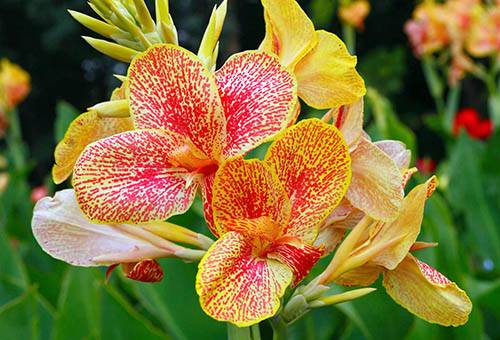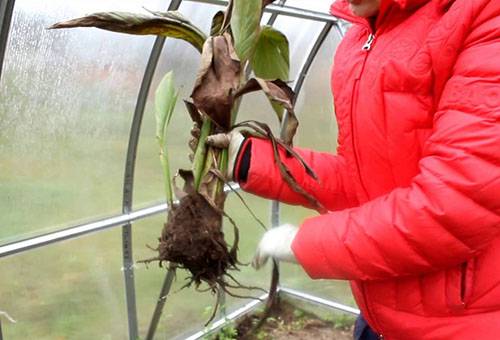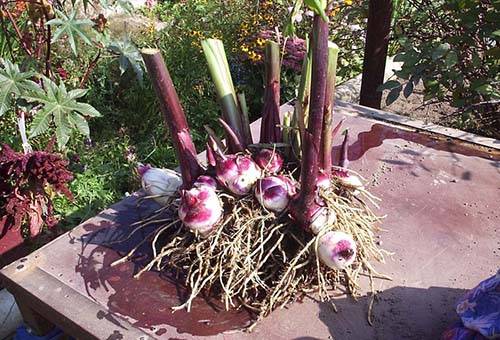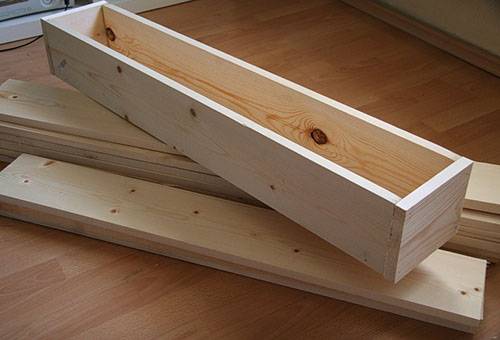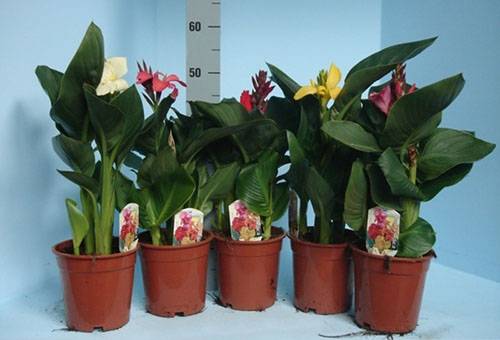How to store cannes in winter and can you see flowers on them in January?
Content:
Cannes cultivation became a hobby of many flower growers not only from the southern regions of Russia, but also from the middle strip, from the Urals and the Far East. If at the latitude of Sochi these subtropical plants easily winter in the open ground, then north of the subtropics, storage in the cold season can only be provided at home. In order for this perennial to feel good at home in the winter, you need to get acquainted with the characteristics of the plant and its vegetation.
What do we know about cannes?
Cannes is an unpretentious ornamental plant with wide and large lanceolate leaves, from which in June a flower arrow appears, bearing magnificent, bright and large flowers of red, orange and yellow blooming one after another. The leaves of this perennial are themselves a decoration of the flower garden, they can be pale and dark green.
Florists appreciate this ornamental plant for its rapid growth, decorativeness, unpretentiousness, as well as the fact that such flowers are practically not affected by diseases and pests. From them you can create floral arrangements, picturesque groups, arrange them in the form of a hedge that separates the zones of the garden plot from each other.
Breeders have created many varieties of cannas - from half a meter to 2.5-3 meters high, with peduncles of different colors and shades. If you properly organize the storage of this ornamental plant in the winter, you can for many years enjoy the cultivation of perennials.
Cannes digging time
Each plant needs the roots or bulbs to get as many nutrients as possible - this makes it possible to painlessly transfer the period of winter dormancy. The signal is a steady decrease in ambient temperature. For a plant like cannes, this is the period after the first frost. Cooling is a signal that it is time to prepare for wintering, and therefore, all nutrients rush to the rhizome.
Tip
Keep in any form a short diary of the main works in the garden, in the flower garden, in the garden. Regular notes will help you better prepare for technological operations, pre-stock inventory, containers, seeds and seedlings.
This serves as a guarantee for the plant that in spring it will be able to start a new vegetative cycle. For the middle band, this period will be the end of September - the beginning of October, for the more southern regions the dates are somewhat shifted. If you start the process of digging out before the first frosts, then the root system will go to winter, not having received enough nutrition.
How to dig plants?
Before digging up the rhizomes from the plant, it is necessary to cut off all the peduncles, leaving a stump about 20 cm long. Then the perennial is carefully dug up and removed from the ground. No need to remove the earth from the roots, wash them - the remains of the soil will help not to lose the necessary moisture in the winter. Before laying flowers for storage, they need to be dried for several days in the shade. This is best done under a canopy or in a barn.
Tip
If you have several varieties of this ornamental plant, attach a tag with the name of the variety to the remainder of the peduncle. It can be made of dense foil, cardboard, plastic. In the spring it will be easier to create a floral arrangement, taking into account the characteristics of the variety.
Be sure to inspect the excavated tubers, removing damaged, rotted roots with kidneys. This is a convenient case to divide the plant, leaving 1-2 healthy buds on each tuber.The cut points must be dried and sprinkled with crushed charcoal for disinfection. Experienced flower growers advise the perennial division to be postponed until spring, when it will be clear how the plant wintered.
Bookmark for storage
You can save this flower in winter in several ways. First you need to prepare the containers in which the storage will take place, as well as peat, sand, sawdust and a thermometer to measure the air temperature in the room.
We describe the most common methods.
- Storage in cardboard boxes, wooden boxes.
Cannes tubers are placed in containers, pouring them with a mixture of sand, sawdust, peat. It is advisable to take sawdust for the substrate from fruit trees.
The optimum temperature for such storage is + 8 ° C. Substrate needs to be moistened from time to time, but not too much so as to prevent the appearance of rot. Such temperature conditions and optimal humidity can be created in the cellar or in the basement.
Tip
Every month, it is necessary to conduct an audit of tubers, cutting rotten places and sprinkling with ash or coal, ground cinnamon. Dry soil is moistened additionally.
- Storage in a pot.
A flower with clipped peduncles, together with a lump of earth, is placed in a cool, bright room. It can be a loggia or a porch, that is, a room where the temperature does not rise above 13 ° C. This method imitates the natural conditions of a tropical winter, to which Cannes are accustomed, it guarantees excellent preservation and maturation of flower buds. Once a month, the soil is watered, but not too abundantly.
Tip
The frequency of watering closer to planting a perennial on a flower bed needs to be increased, before planting in May - feed with full mineral fertilizer for ornamental plants.
- Storage in a flower container.
In this way, you can store cannes while enjoying their flowering. It is important to have time to dig up flowers before the first frost. Their flower stalk is not cut, as the perennial continues to bloom at home. This method is perfect for low varieties, although if there is enough space, the winter garden will only benefit from cannes of any size. The care of such plants is slightly different - they need to be regularly watered and fed, placed in the brightest place of the house. Perennial flowering can be admired until January.
Tip
In order not to weaken the plant, he needs to provide a dormant period from February to April, by cutting dry leaves and limiting watering.
How to get out of the winter?
If you plan to plant plants immediately in open ground, then in April you need to get the tubers from the substrate and begin their adaptation to new conditions, taking them out to fresh air on a sunny day. Then each tuber is inspected, sprinkled with ash, crushed charcoal, dipped in the root stimulator “Kornevin” and planted in a permanent place.
You can germinate perennial in pots in advance.
Germination mixture composition:
- sand - 1 part;
- humus - 1 part;
- fertile land - 2 parts.
In March, all delenki with the treated places of the cuts are planted in the substrate, sprinkled on top of 2 cm of soil, watered with warm water. After a week, the flower buds will start growing, and we can assume that the successful wintering is over.
In order for the decorative perennial to successfully winter, you need to create conditions for it that are close to the conditions of a tropical winter - coolness and moderate watering. It is necessary to constantly control the humidity, preventing the formation of rot. The reward for a patient and responsible grower will be the beautiful flowering of a strong and healthy plant.
Read the article on how to care for amaryllis
